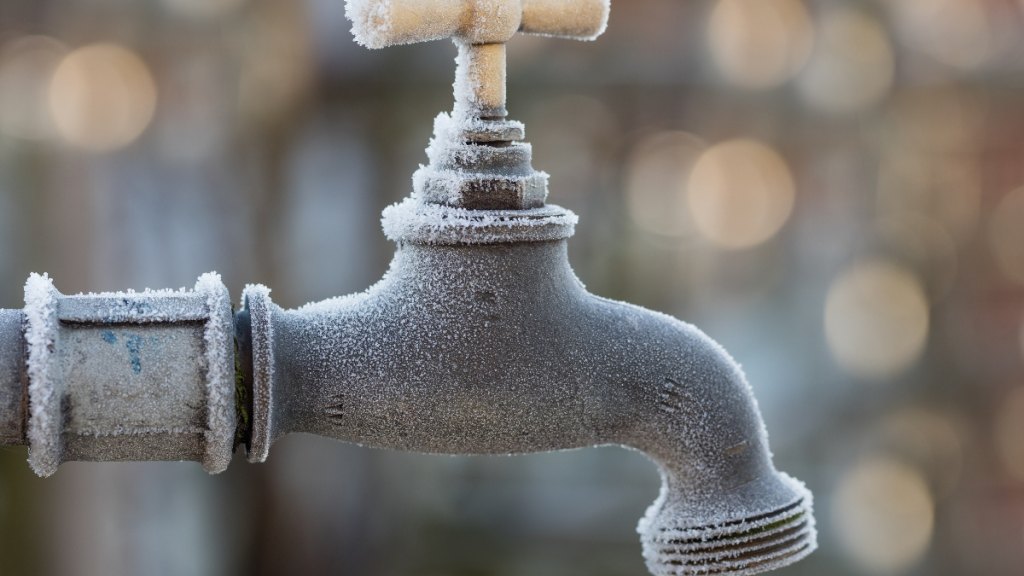When temperatures plummet, homeowners and renters often have the same concern about their residence: Frozen pipes. This dreaded plumbing problem can not only impact your heating system and clean water supply, it can also lead to a host of other far more costly problems if not dealt with properly. Thankfully, there are steps you can take to not only fix frozen pipes, but help prevent this issue from occurring in the first place.
What causes frozen pipes?
“Pipes freeze when temperatures drop below freezing, causing the water inside to solidify,” says Allison Harrison, co-owner at Goodbee Plumbing and Drains. The most common cause of frozen pipes? “When you have poor insulation so that pipes are exposed to cold air outside and in unheated areas of the home inside.”
The location of the pipes can also make them more likely to be affected. “Pipes that are in unheated spaces like a garage, and pipes that run along external walls are more vulnerable to freezing when the temperature drops,” adds Hendrik Vandepoll, co-owner and field manager of Service Force Plumbing. “And outdoor spigots can transmit cold to inner pipes and freeze them within the house, as well.”
The hidden dangers of frozen pipes
An even bigger issue: If you don’t take steps to fix a frozen pipe, you could end up with burst pipes which cost an average of $10,250 worth of damage!
“Even if the water’s turned off, if the pipe is holding water, the water will expand that pipe and then cause a little slice, usually about an inch or two long,” warns master plumber John Beron of Shafer Services Plus. “Then you have a leak as soon as it all thaws out. If you don’t catch it in time, it could be a major issue for a building.”
Here are some of the most common problems:
- Water damage: When pipes freeze, the water inside them expands as it turns to ice, which can lead to burst pipes. When the ice thaws, it can result in water leakage, causing damage to walls, ceilings, floors and belongings, explains Harrison.
- Loss of water supply: Frozen pipes can block the flow of water, leading to a loss of water supply to your home until the pipes thaw.
- Expensive repairs: Repairing burst pipes and addressing water damage can be costly, especially if the issue is widespread or if it’s not promptly addressed, explains Harrison.
- Disruption of daily activities: Daily activities from cooking and cleaning to showering and bathing can be disrupted.
- Health risks: In severe cases, frozen pipes can lead to mold growth due to water damage.
- Energy waste: Frozen pipes can also impact heating systems, as they may freeze if the pipes supplying them with water freeze, explains Harrison. “This can lead to increased energy consumption as the heating system works harder to compensate.”
Signs your pipes are frozen
Since burst pipes can result in serious water damage to a home or property, you may wonder what you should be looking for to determine if they’re near frozen. “You can tell if your pipes are starting to freeze if you hear them banging or making a gurgling sound, which is the water solidifying and expanding,” explains plumber Simon Seys of Plumbing Instant Fix. Another clue: “Look at pipes under your bathroom or kitchen sink — if you see condensation on the outside of the pipes, it’s a sign they’re getting too cold.”
You may also notice reduced water flow or no water at all. “Basically a fixture like a faucet doesn’t work when it should,” says Roy Barnes, co-owner and service manager of Service Force Plumbing. “You could check the temperature of the pipe with a laser thermometer gun to verify it, but if it’s cold and your tap normally works but doesn’t, the supply pipe is probably frozen.”
Unusual odors, visible frost and bulging pipes are some other signs to watch out for. (Note: Harrison says that cracks or swelling in pipes could mean there’s an ice blockage, but that’s a severe case).
How to fix frozen pipes
If you do find yourself dealing with frozen pipes, don’t fret! “Start by locating the frozen section, often identified by frost or a bulging pipe,” says Matt Kunz, president of Mr. Rooter Plumbing, a Neighborly company.
1. Turn on the faucet
Your go-to solution is actually quite simple once you’ve located the culprit. “The best way to thaw a pipe is to let it thaw naturally,” explains Harrison. “To thaw a frozen pipe safely, open nearby faucets and run warm water to relieve the pressure.”
2. Apply heat, gently
If turning the faucet on doesn’t work, you may need to help move things along. “Begin the thawing process by applying gentle heat using methods like a hairdryer, heating pad or towels soaked in hot water,” shares Kunz.
An important note when you need to warm the pipe: “You don’t want to start in the middle, you want to thaw closest to the exit point so water or steam can flow out,” adds Barnes. But be sure not to apply too much heat at once!
See how to use a hairdryer in the video below:
What not to do when fixing frozen pipes
Experts do caution that thawing a pipe manually can be a tricky task, and sometimes you won’t have any other option but to wait it out until the weather warms up a bit.
In some cases, you may not even be able to fully reach the pipe to help speed up the process. “If you don’t have access to the entire pipe (it runs into the floor or behind a wall, for example) any efforts you apply to the section of the pipe you can see won’t have much effect on the hidden sections,” says Vandepoll.
If you can access the entire pipe and decide to take the thawing into your own hands, there’s one thing you want to avoid. “You don’t want to apply extreme heat, like a propane torch for example,” cautions Vandepoll. “The thermal shock of doing that could crack the pipe when it would have eventually been fine otherwise.”
When to call a plumber
If you can’t locate the frozen section or water still won’t flow after thawing, it’s time to call a professional. Some pipes run behind walls or under floors, making them impossible to reach, and a plumber can bring the tools to thaw hidden pipes safely.
How to prevent frozen pipes

Dealing with frozen pipes can be rather stressful, even if they don’t end up bursting. To ensure you don’t have to worry about the issue, there are steps you can take to prevent it in the first place.
1. Insulate exposed pipes
A great place to start: Insulate exposed pipes, says Harrison. This insulation can be found in hardware stores for about 50 cents per foot.
If you can’t find any pipe insulation or want to save even more money, there’s an equally useful alternative you may have right in your garage: A pool noodle! All you have to do is cut the noodle to the length of your pipe, carefully cut a slit lengthwise and slip it over the pipe.
Watch this trick in action in the video below:
2. Let the warmth in
“When temperatures drop below freezing, it’s also recommended to leave cabinet doors open to allow warm air to circulate around the pipes,” adds Harrison.
Space heaters can help keep pipes from freezing, be sure to use them only in areas deemed safe by the manufacturer. “You can use a fan to blow warm air from a heater into a space where pipes are vulnerable,” shares Barnes.
3. Disconnect and drain outdoor hoses
Disconnect and drain outdoor hoses, and shut off the outdoor water supply if possible. “If you leave a hose full of water connected to the spigot, it cannot drain, and it has a high risk of freezing and cracking,” says Barnes. Instead, store them inside during the winter.
4. Leave a small drip
“Also, be sure to keep the faucet drip on to keep water moving,” says Harrison. Running water, even at a trickle, can help prevent pipes from freezing.
5. Seal cracks
Consider sealing any noticeable gaps or cracks in your walls or foundation to keep cold air out. This will help make sure your pipes aren’t affected by a temperature drop.
6. Install a smart thermostat
Consider installing a smart thermostat that can monitor indoor temperatures and alert you if they drop to levels that could lead to frozen pipes.




